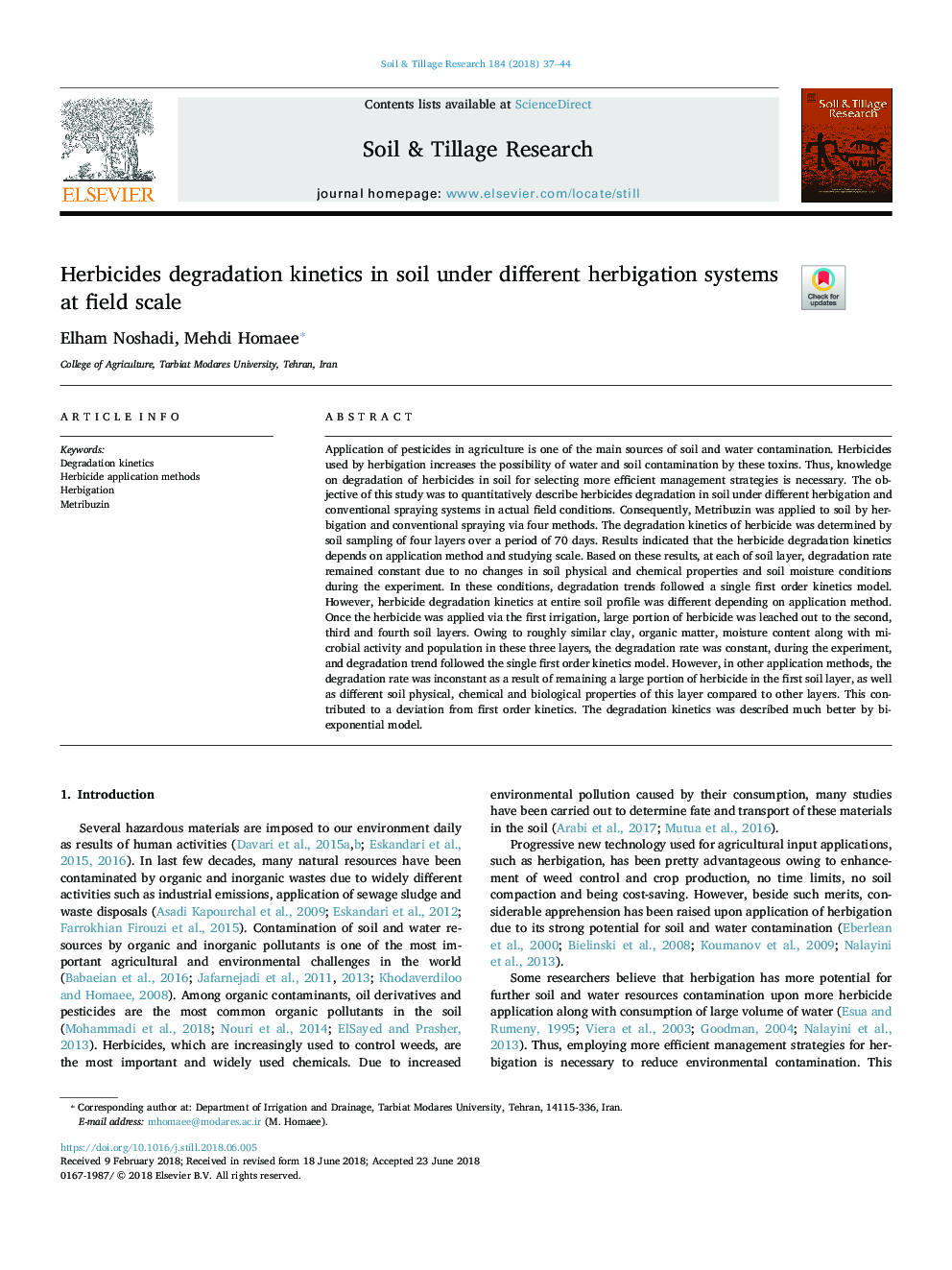| کد مقاله | کد نشریه | سال انتشار | مقاله انگلیسی | نسخه تمام متن |
|---|---|---|---|---|
| 6772878 | 1431819 | 2018 | 8 صفحه PDF | دانلود رایگان |
عنوان انگلیسی مقاله ISI
Herbicides degradation kinetics in soil under different herbigation systems at field scale
ترجمه فارسی عنوان
سینتیک تخریب علف کش ها در خاک تحت سیستم های مختلف کشت و زرع در مقیاس مرتعی
دانلود مقاله + سفارش ترجمه
دانلود مقاله ISI انگلیسی
رایگان برای ایرانیان
کلمات کلیدی
سینتیک تخریب، روش های کاربرد علف کش، حشره کش، متبریوزین،
ترجمه چکیده
استفاده از آفت کش ها در کشاورزی یکی از منابع اصلی آلودگی خاک و آب است. علف کش های استفاده شده توسط حشره کش ها باعث افزایش احتمال آلودگی آب و خاک توسط این سموم می شود. بدین ترتیب، دانش تخریب علف کش ها در خاک برای انتخاب راهکارهای مدیریت کارآمد ضروری است. هدف از این تحقیق، کیفی کردن تخریب علف کش ها در خاک در شرایط مختلف حیوانی و سیستم های معمول سمپاشی بود. در نتیجه، متیروبزین به وسیله روش کشت و اسپری معمول توسط چهار روش به خاک اعمال شد. سینتیک تخریب علف کش توسط نمونه گیری خاک از چهار لایه در طی 70 روز تعیین گردید. نتایج نشان داد که سینتیک تخریب علف کش بستگی به روش کاربرد و مقیاس مطالعه دارد. بر اساس این نتایج، در هر لایه خاک، میزان تخریب با توجه به هیچ تغییری در خواص فیزیکی و شیمیایی خاک و شرایط رطوبت خاک در طی آزمایش ثابت نبود. در این شرایط، روند تخریب به دنبال یک مدل سینتیک تک منظوره بود. با این وجود، سینتیک تجزیه علف کش در تمام مشخصات خاک بستگی به روش کاربرد دارد. هنگامی که علف کش از طریق اولین آبیاری استفاده شد، بخش بزرگی از علف کش به لایه های دوم، سوم و چهارم برسد. با توجه به تقریبا مشابه رس، ماده آلی، رطوبت و فعالیت میکروبی و جمعیت در این سه لایه، میزان تخریب در طی آزمایش ثابت و روند تخریب به دنبال مدل سینتیک تک منظوره بود. با این حال، در روش های دیگر کاربرد، میزان تخریب ناشی از باقی مانده بخش بزرگی از علف کش در اولین لایه خاک، و همچنین خواص فیزیکی، شیمیایی و بیولوژیکی خاک این لایه نسبت به سایر لایه ها بود. این منجر به انحراف از سینتیک درجه اول شد. سینتیک تخریب توسط مدل بی پارامتر بسیار بهتر توصیف شد.
موضوعات مرتبط
مهندسی و علوم پایه
مهندسی انرژی
انرژی های تجدید پذیر، توسعه پایدار و محیط زیست
چکیده انگلیسی
Application of pesticides in agriculture is one of the main sources of soil and water contamination. Herbicides used by herbigation increases the possibility of water and soil contamination by these toxins. Thus, knowledge on degradation of herbicides in soil for selecting more efficient management strategies is necessary. The objective of this study was to quantitatively describe herbicides degradation in soil under different herbigation and conventional spraying systems in actual field conditions. Consequently, Metribuzin was applied to soil by herbigation and conventional spraying via four methods. The degradation kinetics of herbicide was determined by soil sampling of four layers over a period of 70 days. Results indicated that the herbicide degradation kinetics depends on application method and studying scale. Based on these results, at each of soil layer, degradation rate remained constant due to no changes in soil physical and chemical properties and soil moisture conditions during the experiment. In these conditions, degradation trends followed a single first order kinetics model. However, herbicide degradation kinetics at entire soil profile was different depending on application method. Once the herbicide was applied via the first irrigation, large portion of herbicide was leached out to the second, third and fourth soil layers. Owing to roughly similar clay, organic matter, moisture content along with microbial activity and population in these three layers, the degradation rate was constant, during the experiment, and degradation trend followed the single first order kinetics model. However, in other application methods, the degradation rate was inconstant as a result of remaining a large portion of herbicide in the first soil layer, as well as different soil physical, chemical and biological properties of this layer compared to other layers. This contributed to a deviation from first order kinetics. The degradation kinetics was described much better by bi-exponential model.
ناشر
Database: Elsevier - ScienceDirect (ساینس دایرکت)
Journal: Soil and Tillage Research - Volume 184, December 2018, Pages 37-44
Journal: Soil and Tillage Research - Volume 184, December 2018, Pages 37-44
نویسندگان
Elham Noshadi, Mehdi Homaee,
